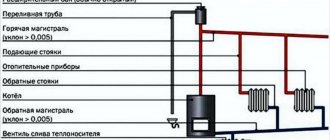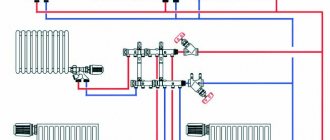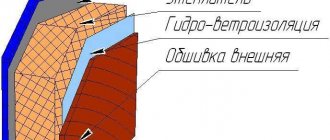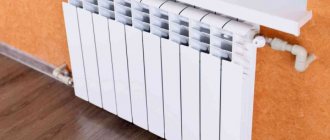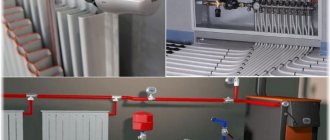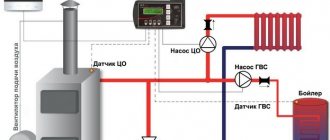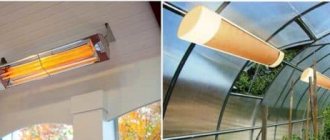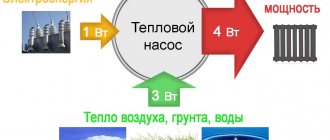With rising energy prices, the use of alternative energy sources is becoming increasingly important. And since heating is the main expense item for many, we are talking about heating first of all: you have to pay considerable amounts almost all year round. When you want to save money, the first thing that comes to mind is solar heat: a powerful and completely free source of energy. And it’s quite possible to use it. Moreover, although the equipment is expensive, it is several times cheaper than heat pumps. Let's talk in more detail about how solar energy can be used to heat a house.
Solar heating: pros and cons
If we talk about using solar energy for heating, then you need to keep in mind that there are two different devices for converting solar energy:
- Solar panels. They produce exclusively electric current. But you can already use it to ensure the operation of any electrical equipment, including the operation of heating devices.
- Solar collectors. These devices heat the liquid (coolant) and can be directly connected to the heating system, and can also be used to heat water for domestic needs.
This way you can provide your home with hot water and partial heating using solar energy.
Both options have their own characteristics. Although it must be said right away, whichever one you choose, do not rush to abandon the heating system that you have. The sun rises, of course, every morning, but your solar cells will not always get enough light. The most reasonable solution is to make a combined system. When the sun's energy is sufficient, the second heat source will not work. This way you will protect yourself, live in comfortable conditions, and save money.
If there is no desire or opportunity to install two systems, your solar heating should have at least a double power reserve. Then we can say for sure that you will have warmth in any case.
Advantages of using solar energy for heating:
- A safe and absolutely “clean” source of energy.
- Reduced heating and hot water costs.
- You are independent of the state of the economy: the sun always shines, both in crisis and in times of prosperity.
- The sun does not require money for its energy. Another thing is that the state can impose taxes on the owners of solar installations. But so far this has not happened - solar energy is free.
The sun constantly sends heat to the earth. And you can use it to heat your home
Flaws:
- Dependence of the amount of incoming heat on the weather and region.
- For guaranteed heating, you will need a system that can operate in parallel with a solar heating system. Many heating equipment manufacturers provide this possibility. In particular, European manufacturers of wall-mounted gas boilers provide for joint operation with solar heating (for example, Baxi boilers). Even if you have installed equipment that does not have this capability, you can coordinate the operation of the heating system using the controller.
- Solid financial investment at the start.
- Periodic maintenance: tubes and panels must be cleaned of adhering debris and washed from dust.
- Some of the liquid solar collectors cannot operate at very low temperatures. On the eve of severe frosts, the liquid must be drained. But this does not apply to all models and not all liquids.
Now let's take a closer look at each type of solar heating element.
Advantages of using solar panels.
The use of these sources of electrical energy for water heaters in a private home provides a wide range of advantages over other heating devices:
- no toxic emissions into the environment due to the absence of energy combustion;
- manufacturing them of different power makes it possible to obtain a sufficient amount of electrical energy from solar panels for the full functioning of the heating system and other electrical appliances;
- the absence of flammable energy carriers eliminates the possibility of accidental fire , of course, if the electrical connections and wiring are made in compliance with all safety requirements;
- the use of photocells that convert infrared radiation makes it possible to generate electricity even under heavy cloud cover ;
- full electrification of the house is ensured , regardless of other energy sources;
- installed equipment does not require additional investments over a long period;
- heating technology using solar panels provides the opportunity to fully automate the entire cycle of work processes: obtaining electrical energy, heating the house, controlling and maintaining the required temperature;
- Manufacturers guarantee reliable operation of solar panels without additional investments for 30 years.
Solar collectors
Solar collectors are used for solar heating. These installations use the heat of the sun to heat the coolant fluid, which can then be used in a water heating system. The specificity is that a solar water heater for heating a house produces only a temperature of 45-60°C, and shows the highest efficiency at an output of 35°C. Therefore, such systems are recommended for use in conjunction with warm water floors. If you don’t want to give up radiators, either increase the number of sections (approximately twice as much) or heat up the coolant.
To provide the house with warm water and for water heating, you can use solar collectors (flat and tubular)
Now about the types of solar collectors. Structurally there are two modifications:
- flat;
- tubular.
In each of the groups there are variations in both materials and design, but they have the same operating principle: a coolant runs through the tubes, which is heated by the sun. But the designs are completely different.
Pros and cons of heating your home using the sun
At present, unfortunately, such systems have not yet received widespread use in housing construction and utility networks, due to the fact that obtaining electricity from the sun is still more expensive than from traditional power plants, and electricity generation is only possible during daylight hours time of day and in good weather.
However, this technology has many advantages. The advantages of using solar energy for heating a home are:
- high environmental friendliness;
- independent temperature regulation;
- autonomy from utilities;
- long service life;
- there is no need to pay for electricity and constantly worry about fuel supplies.
The disadvantages of solar battery systems include the following:
- problematic use in regions with frequent precipitation and constant cloudiness;
- the need for large free areas for installation of the system;
- high price;
- low efficiency in bad weather;
- the need to purchase additional equipment;
- long-term payback.
Flat-plate solar collectors
These solar heating units have a simple design and therefore can be made with your own hands if desired. A durable bottom is secured to a metal frame. A layer of thermal insulation is laid on top. The housing walls are also insulated to reduce losses. Then there is a layer of adsorber - a material that absorbs solar radiation well, turning it into heat. This layer is usually black in color. The adsorber is equipped with pipes through which the coolant flows. From above, this entire structure is closed with a transparent lid. The material for the cover can be tempered glass or one of the plastics (most often it is polycarbonate). In some models, the light-transmitting material of the cover may undergo special treatment: to reduce reflectivity, it is made not smooth, but slightly matte.
Design of a flat-plate solar collector
The pipes in a flat-plate solar collector are usually laid in a snake pattern, and there are two holes - inlet and outlet. Single-pipe and two-pipe connections can be implemented. This is what you like. But for normal heat exchange a pump is needed. A gravity-flow system is also possible, but it will be very inefficient due to the low speed of the coolant. It is this type of solar collector that is used for heating, although it can be used to efficiently heat water for hot water supply.
There is a variant of a gravity collector, but it is used mainly for heating water. This design is also called a plastic solar collector. These are two plates made of transparent plastic, hermetically fixed to the body. There is a labyrinth inside to move water. Sometimes the bottom panel is painted black. There are two holes - inlet and outlet. Water is supplied inside, warmed by the sun as it moves through the labyrinth, and comes out warm. This scheme works well with a water tank and easily heats water for domestic hot water. This is a modern replacement for a conventional barrel installed on an outdoor shower. Moreover, a more effective replacement.
A plastic collector is used to heat water
How efficient are solar collectors? Among all household solar installations today they show the best results: their efficiency is 72-75%. But not everything is so good:
- they do not work at night and do not work well in cloudy weather;
- large heat losses, especially in windy conditions;
- low maintainability: if something breaks down, then a significant part, or the entire panel, needs to be replaced.
However, heating a private house from the sun is often done using these solar installations. Such installations are popular in southern countries with active radiation and positive temperatures in winter. They are not suitable for our winters, but in the summer season they show good results.
What solar panel sellers are silent about
If you look through forums and reviews, you can find such warnings from happy owners of solar panels.
- Panels require a grid inverter to operate: when purchasing panels, you need to coordinate the voltage of the inverter and the panels for compatibility.
For example, to operate two panels, each rated at 100 watts, you will need a 300-500 watt inverter.
Chinese and usually quite high-quality inverters still often indicate on the case a power that does not correspond to reality. Be careful when purchasing and check the details. The device operates when there is mains voltage, so it cannot be a backup power source. If the electricity is not consumed immediately, it is sent back to the grid. At the same time, the counter rotates either forward or backward. This is unusual and is not taken into account by many counters. There is a risk of paying for the energy returned
It is important to consider the type of meter and include the cost of replacing it in your calculations. If your area is often cloudy, it is important to take it into account and equate it with shade. It is important to consider the time and effort required to clean the panels, especially in winter from snow.
The main conclusion of those who purchased panels in our country is that for now it is too expensive and should be considered as a hobby.
Air manifold
This installation can be used for air heating of the house. Structurally, it is very similar to the plastic collector described above, but air circulates and heats up in it. Such devices are hung on walls. They can operate in two ways: if the solar air heater is sealed, air is taken from the room, heated and returned to the same room.
The air manifold is installed on the south wall
There is another option. It combines heating with ventilation. There are holes in the outer housing of the air manifold. Through them, cold air enters the structure. Passing through the labyrinth, it is heated by the sun's rays, and then warmed up it enters the room.
Such heating of the house will be more or less effective if the installation occupies the entire southern wall, and there is no shadow on this wall.
Advantages and disadvantages of this technology
Any really existing system has its pros and cons, and so does a solar power plant. The advantages include the following factors:
- Autonomy. The quality of your life will no longer depend on the health of government power grids. It's no secret that periodic power outages can be quite nerve-wracking. And if you work at home, then you simply need an autonomous power supply, otherwise the lack of electricity can lead not only to moral, but also to material costs.
- Variability. Possibility of gradual capacity increase. You don't have to switch your entire house to solar energy at once. To begin with, one panel and a car battery will be enough, from which you can easily power several LED lamps or street lights. As an experiment and to gain the necessary experience, you can start with a solar-powered fountain or electrifying the kitchen. Gradually increasing the power of the system, you can move on to more serious devices, for example, connecting fans in the summer and a small heater in the winter. And having thoroughly studied the topic, you can begin global projects, convert heating to solar energy or power a greenhouse.
- Environmental Safety. During the production of electrical energy, no harmful elements are released into the environment, and when disposing of failed components, no harmful compounds are formed.
- Legality. To purchase and install solar panels on your roof or area adjacent to your home, you will not need any additional permits.
- Durability. If the elements in the panels are of high quality and connected correctly, and the batteries themselves are installed according to all the rules, the system will serve you for decades.
Now about the disadvantages:
Given the current situation with carbon-based energy sources, whether to switch to alternative energy sources or not is not a question. The main thing here is to decide which renewable resource is right for you. If the information in this article was useful to you, share it with your friends and don’t forget to subscribe to our blog, there is still a lot of interesting things to come.
Tubular manifolds
Here, too, the coolant circulates through pipes, but each of these heat exchange pipes is inserted into a glass flask. They are all connected in a manifold, which is essentially a comb.
Diagram of a tubular collector (click to enlarge the picture)
Tubular collectors have two types of tubes: coaxial and feather. Coaxial - a pipe in a pipe - nested one inside the other and their edges are sealed. A rarefied airless environment is created inside between the two walls. That is why such tubes are also called vacuum tubes. Feather tubes are just a regular tube sealed on one side. And they are called feather ones because, to increase heat transfer, an adsorber plate is inserted into them, which has curved edges and is somewhat reminiscent of a feather.
In addition, heat exchangers of different types can be inserted into different housings. The first are the Heat-pipe thermal channels. This is a whole system for converting sunlight into thermal energy. A heat-pipe is a small-diameter hollow copper tube sealed at one end. On the second there is a massive tip. A substance with a low boiling point is poured into the tube. When heated, the substance begins to boil, part of it turns into a gaseous state and rises up the tube. Along the way from the heated walls of the tube, it heats up more and more. It ends up in the upper part, where it stays for some time. During this time, the gas transfers part of the heat to the massive tip, gradually cools, condenses and settles down, where the process is repeated again.
Scheme of operation of the Heat-pipe thermal channel
The second method is U-type, which is a traditional tube filled with coolant. There's no news or surprises here. Everything is as usual: the coolant enters on one side, passes through the tube, and is heated by sunlight. Despite its simplicity, this type of heat exchanger is more effective. But it is used less often. And all because solar water heaters of this type form a single whole. If one tube is damaged, the entire section must be replaced.
Tubular collectors with a Heat-pipe system are more expensive, show lower efficiency, but are used more often. And all because a damaged tube can be changed in a couple of minutes. Moreover, if a coaxial flask is used, then the tube can also be repaired. It is simply disassembled (the top plug is removed) and the damaged element (thermal channel or the bulb itself) is replaced with a working one. The tube is then inserted into place.
Regular U-tube is the most efficient heat channel
The principle of operation of solar systems for heating water
The efficiency of new collectors, with special filters for capturing waves of different lengths , is pleasing with its value - at least 40% . Conventional silicon panels have an efficiency of no more than 25%.
The service life of heating elements, according to manufacturers, ranges from 10 to 30 years . Other parts of the system, such as batteries and electronics, may fail sooner, in 5 to 15 years.
The principle of operation of batteries is based on the photovoltaic effect. Radiant energy passing through photocells is converted into electrical energy. An accessible example is watches and calculators with photocells , which have been demonstrating this operating principle to us at a primitive level for several decades.
How to choose a heat pump for heating your home? Types of pumps and the principle of their operation. Is it true that an induction boiler for heating a private home significantly saves energy costs? Find out in this article.
Which collector is better for heating?
For southern regions with mild winters and many sunny days a year, the best option is a flat-plate collector. In such a climate it shows the highest productivity.
For regions with harsher climates, tubular collectors are suitable. Moreover, systems with Heat-pipe are more suitable for harsh winters: they heat even at night and even in cloudy weather, collecting most of the solar radiation spectrum. They are not afraid of low temperatures, but the exact temperature range needs to be clarified: it depends on the substance located in the thermal channel.
These systems, when properly calculated, can be basic, but more often they simply save heating costs from another, paid source of energy.
Tubular solar systems are more suitable for Russia
Another auxiliary heating could be an air manifold. It can be made to cover the entire wall, and it can be easily done with your own hands. It is perfect for heating a garage or cottage. Moreover, problems with insufficient heating may arise not in winter, as you expect, but in autumn. In frost and snow, the sun's energy is many times greater than in cloudy, rainy weather.
Experience in using solar vacuum collectors from other countries
Sub**r, Belarus
From October until the New Year, the water in the storage tank did not heat up above 16 degrees, the collector was blown with snow, they say it was installed incorrectly. On January 7, it was -32 outside, but the sensors and controller showed that by 12 noon the water had heated up to +30. I probably didn’t install enough tubes; for our 200-liter tank it’s better to install 30-40.
I assembled everything myself, there may be some mistakes, but I think that equipment sellers are lying about efficiency. Although for me this is more of an experiment, the price and payback period are not entirely encouraging.
9eb8830d456fc3e23a515ef9402c382a.jpe
I***rs
We decided to start selling solar collectors and test a vacuum one. They put it on a colleague in a private house. We chose it based on the need - for hot water, with a separate tank installed inside the house. Tank 135 liters, one manifold for 12 tubes 58 mm in diameter and 1800 mm in length.
The “owner” is satisfied, since the tank, manifold, controller and control unit were given to him free of charge. The employee purchased the rest of the consumables himself.
From July to mid-October, the collector heated one tank per day to 50 degrees, if it was constantly sunny - 2 tanks. That is, 135 and 270 liters, respectively. In winter, heating is very efficient, as judged by the number of pump activations for pumping. We made a mistake with the installation - the pipes were long (about 30 meters), which meant large losses. And the installation of the sensor is incorrect - it was installed in the manifold, not in the tank. In general, ideally you need to set two to correlate data through the controller.
Dmitry, Belarus (sent from comments)
We installed two vacuum manifolds with 24 tubes each near the house. Not enough for heating, but enough for hot water. The water is just boiling water. The installers helped connect to the heating system to heat the water, and then use a gas boiler to the required 70 degrees.
The savings are obvious, gas consumption has dropped by 30-40%. When the winter passes, we’ll calculate the payback. The only problem is that it was placed at an angle of 45 degrees. Raised to a position closer to the vertical - productivity increased. But the heating temperature depends on cloud cover. Fogs in the morning also have an effect - on such days the tank warms up more slowly. And so, quite satisfied.
Design of a heating system using collectors
First of all, we will take a closer look at the differences in the structure and functioning of batteries and collectors.
The panel consists of several photocells interconnected on a frame made of non-energy-conducting materials.
Photoelectric converters are quite complex structures, representing a kind of sandwich of plates with different characteristics and purposes.
In addition to solar modules and special fasteners, the system consists of the following elements:
- batteries for energy storage;
- controller , which will monitor the state of charge in the battery;
- inverter - to convert direct current into alternating current.
of collectors : vacuum and flat.
Vacuum collectors consist of hollow glass tubes containing smaller diameter tubes containing an energy absorber. Smaller tubes are connected to the coolant. In the free space between them there is a vacuum that retains heat.
The principle of operation of the solar collector
Flat-plate collectors consist of a frame and reinforced glass with a photoabsorbing layer. The absorber layer is connected to the coolant tubes.
Both of these systems consist of a heat exchange circuit and a heat accumulator (liquid tank).
From the tank, water enters the heating system using a pump. To avoid heat loss, the tank must be well insulated.
Such installations should be located on the southern slope of the roof. The tilt angle should be 30–45 degrees. If the location of the house or the roof structure does not allow installing solar system panels on the roof, then you can install them on special reinforced frames or on racks fixed to the wall.
The amount of solar energy released at different times of the year varies greatly . The insolation coefficient for your place of residence can be found on the solar activity map. Knowing the insolation coefficient, you can calculate the number of modules you need.
For example, you consume energy 8 kW/h, insolation is on average 2 kW/h. Solar panel power – 250 W (0.25 kW). Let's do the calculations: 8 / 2 / 0.25 = 16 pieces - this is exactly the number of panels you will need.
